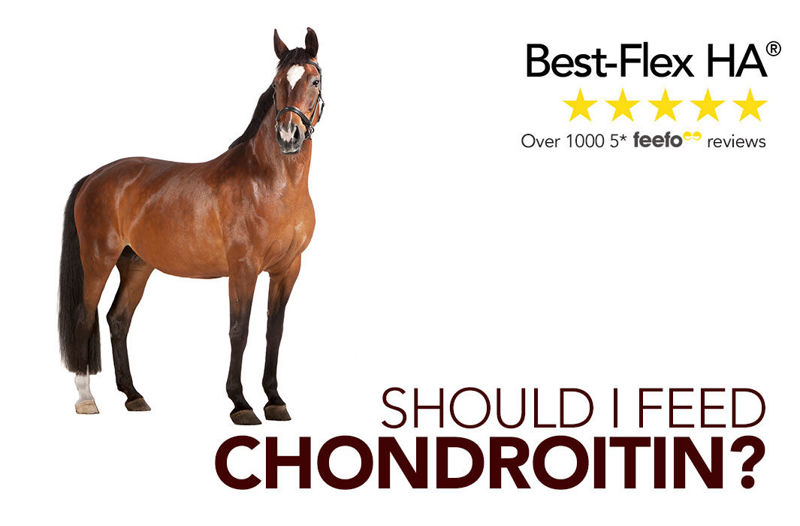Chondroitin sulphate is a glycosaminoglycan (GAG) that supports cartilage production (Schiraldi et al. 2010). GAGs also form proteoglycans when combined with proteins which give articular cartilage its compression-resistant and shock absorbing properties (Barclay, 1998). Human studies have shown that supplementation with Chondroitin sulphate reduces joint pain and improves articular function (Uebelhart et al. 1998; Mazieres et al. 2001; Uebelhart et al. 2004); reduces joint swelling (Clegg et al. 2006) and prevents joint space narrowing of the knee and fingers (Rovetta et al. 2002; Verbruggen et al. 2002).
Chondroitin use in equines
Chondroitin sulphate supplementation has also been well researched in horses, often in combination with glucosamine. In vitro studies have shown that when supplemented alongside glucosamine, chondroitin sulphate reduces glycosaminoglycan degradation (Orth et al. 2002; Dechant et al. 2005). As the earliest recognisable and central feature to degenerative change in joints is loss of glycosaminoglycans from articular cartilage (Wright, 2011), supplementing with chondroitin sulphate, alongside glucosamine may help to support optimal joint health (Orth et al. 2002). This is further supported in research conducted by Fenton et al. (2000) who demonstrated that both glucosamine and Chondroitin sulphate can inhibit nitric oxide production, which prevents cartilage degradation, as nitric oxide activates cartilage-degrading enzymes.
Should I feed Chondroitin?
Competition horses are at higher risk of joint issues due to extra wear and tear compared to leisure horses. Alongside glucosamine, supplementing competition horses’ diets with Chondroitin sulphate over a 6-year period reduced the requirement of hock joint injections from 1.7 injections per year prior to supplementation to 0.85 injections per year (Rodgers, 2006).
As horses age, and due to injury and general 'wear and tear' articular cartilage degrades, reducing joint movement and compromising mobility. Forsyth et al. (2006) supplemented veteran horses (older than 20 years) with 2000mg of chondroitin sulphate and 5000mg of Glucosamine or a placebo. Those supplemented with the chondroitin sulphate and Glucosamine showed a significant increase in range of motion of the elbow, stifle and hind fetlock as well as a significant increase in stride length and swing duration. The authors concluded that these results indicated the supplement offered symptomatic relief to veteran horses suffering with potential joint issues.
Chondroitin in Best-Flex HA®
Best-Flex HA® supplies 6500mg of Chondroitin sulphate per day, which far exceeds the quantity found in all other joint supplements for horses in the UK. Best-Flex HA® also supplies 17000 mg of Glucosamine, as studies have shown that supplementing both ingredients together offers ultimate joint protection.
References
- Barclay, T.S., Tsourounis, C., and McCart, G.M (1998). ‘Glucosamine’, Annals of Pharmacotherapy 32(5), pages 574-579.
- Clegg, D.O., Reda, D.J., Harris, C,L., Klein, M.A., O'Dell, J.R. and Hooper, M.M. (2006) ‘Glucosamine, chondroitin sulfate, and the two in combination for painful knee osteoarthritis’ The New England Journal of Medicine, 354, pages 795-808
- Dechant, J.E., Baxter, G.M., Frisbie, D.D., Trotter, G.W. and McIlwraith, C.W. (2005) ‘Effects of glucosamine hydrochloride and chondroitin sulphate, alone and in combination, on normal and interleukin-1 conditioned equine articular cartilage explant metabolism’, Equine Veterinary Jounral, 37(3), pages 227-31.
- Fenton, J.I., Chlebek-Brown, K.A., Peters, T.L., Caron, J.P. and Orth, M.W. (2000) ‘Glucosamine HCl reduces equine articular cartilage degradation in explant culture’, Osteoarthritis and Cartilage, 8(4), pages 258-265.
- Forsyth, R.K, Brigden, C.V. and Northrop, A.J. (2006) ‘Double-blind investigation of the effects of oral supplementation of combined glucosamine hydrochloride (GHCL) and chondroitin sulphate (CS) on stride characteristics of veteran horses’. Equine Vet Journal Supplement, 36, pages 622-5.
- Mazieres, B., Combe, B., Phan Van, A., Tondut, J. and Grynfeltt, M (2001) ‘Chondroitin sulfate in osteoarthritis of the knee: a prospective, double blind, placebo controlled multicenter clinical study’, Rheumatol, 28, pages 173-181
- Rovetta, G., Monteforte, P., Molfetta, G. and Balestra V. (2002) ‘Chondroitin sulfate in erosive osteoarthritis of the hands’ International Journal of Tissue Reactions, 24, pages 29-32
- Schiraldi, C., Cimini, D. and De Rosa, M. (2010) ‘Production of chondroitin sulfate and chondroitin’. Applied microbiology and biotechnology, 87, pages 1209-1220.
- Uebelhart, D., Malaise, M., Marcolongo, R., DeVathaire, F., Piperno, M. and Mailleux, E. (2004) ‘Intermittent treatment of knee osteoarthritis with oral chondroitin sulfate: a one-year, randomized, double-blind, multicenter study versus placebo Osteoarthritis Cartilage’, 12, pages 269-276
- Uebelhart, D., Thonar, E.J., Delmas, P.D., Chantraine, A and Vignon, E. (1998) ‘Effects of oral chondroitin sulfate on the progression of knee osteoarthritis: a pilot study’, Osteoarthritis Cartilage, 6 (Suppl A), pages 39-46
- Verbruggen, G., Goemaere, S., and Veys, E.M. (2002) ‘Systems to assess the progression of finger joint osteoarthritis and the effects of disease modifying osteoarthritis drugs’, Clinical Rheumatol, 21, pages 231-243

